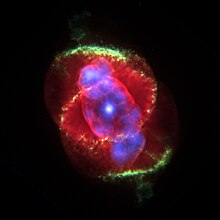This is an old revision of this page, as edited by Stone (talk | contribs) at 15:57, 11 January 2010 (typo). The present address (URL) is a permanent link to this revision, which may differ significantly from the current revision.
Revision as of 15:57, 11 January 2010 by Stone (talk | contribs) (typo)(diff) ← Previous revision | Latest revision (diff) | Newer revision → (diff)
Nebulium was a proposed element found in a nebula by William Huggins in 1864. The strong green emission lines of the Cat's Eye Nebula discovered using spectroscopy led to the postulation that an as yet unknown element was responsible for this emission. In 1927, Ira Sprague Bowen showed that the lines are emitted by doubly ionized oxygen, and no new element was necessary as explanation.
History
In 1802 William Hyde Wollaston and in 1814 Joseph von Fraunhofer described the dark lines within the solar spectrum, but only after Gustav Kirchhoff explained the lines by absorption or emission phenomena of chemical elements was it possible to use the lines for the identification of chemical elements.
In the early days of telescopic astronomy, the word nebula was used to describe any fuzzy patch of light that did not look like a star. Many of these, such as the Andromeda Nebula, had spectra that looked in many ways a lot like stellar spectra, and these turned out to be galaxies. Others, such as the Cat's Eye Nebula, had very different spectra. When William Huggins looked at the Cat's Eye, he found no continuous spectrum like that seen in the Sun, but just a few strong emission lines. The two strong green lines at 4959 and 5007 Ångström were the strongest. These lines did not correspond to any known elements on earth. The fact that helium had been identified in the Sun in 1868 and in 1895 also had beeen found on earth encurraged astronomers to suggested that the lines were due to a new element. The name nebulium was first mentioned by the wife of Huggins in a short comunication in 1898, although it is stated that Huggins occasionally used the term before. (nebulium occasionally nebulum or nephelium). The hypothetical nebulium that was invoked to account for certain bright lines in gaseous nebulae were shown by Ira Sprague Bowen in 1927 as due to doubly ionized oxygen at extremely low density. As Henry Norris Russell put it, "Nebulium has vanished into thin air." But nebulae are typically extremely rarefied, much less dense than the hardest vacuum ever produced on earth. In these conditions, atoms behave quite differently and lines can form which are suppressed at normal densities. These lines are known as forbidden lines, and are the strongest lines in most nebular spectra.
References
- Huggins, William; Miller, W. A. (1864). "On the Spectra of some of the Nebulae". Philosophical Transactions of the Royal Society of London. 154: 437–444.
- Huggins, M. L. (1898). ".... Teach me how to name the .... light,". Astrophysical Journal. 8: 54–54.
- Bowen, I. S. (1927). "The Origin of the Nebulium Spectrum". Nature. 120: 473. doi:10.1038/120473a0.
- Hirsh, Richard F. (1979). "The Riddle of the Gaseous Nebulae" (PDF). Isis. 70 (2): 197–212.